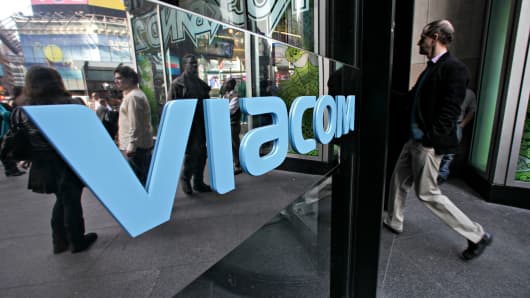US media executives could be forgiven for feeling a pang of déja-vu this week. Just six months after a slump erased $37bn from the stock market value of the biggest media companies in a single day, the sector suffered another bruising few days of anxiety as investors reassessed the value of cable and satellite television.
New disruptive technology, changing viewing habits and a generation of young people lacking the patience to sit through advertisements has knocked confidence in the traditional cable television channel “bundle”, undermining a business model that has held firm for decades.
Wall Street has finally begun to digest this uncomfortable truth and the results have not been pretty. Shares in Time Warner,Viacom, CBS and21st Century Fox were all hit this week. Even companies that expressed optimism about cable television, such asWalt Disney, which said there had been a recent uptick in cable subscribers at its ESPN sports channel, were briefly swept up in the pummelling.
The S&P 500 media index, which includes the biggest names in the sector, has fallen 6 per cent this week — twice as much as the broader market. Viacom was the worst hit, its shares tumbling 25 per cent, after the owner of MTV and Comedy Central reported declines in revenues, operating profit and net income.
The Viacom slide was not helped by Philippe Dauman’s performance on its earnings call, when the chief executive — and newly appointed chairman — said the company’s woes had been exacerbated by “noise” surrounding the company.
More from the Financial Times:
Time shares fall as profits plunge
Viacom chief adds to Redstone drama
Time Warner shares punished
“The damage to credibility created by [the] earnings call will probably take a long time to repair,” wrote Doug Creutz, an analyst with Cowen. Management, he added, “does not appear to have a good handle on the basic mathematics of their business”.
Viacom fell furthest but it was by no means alone. The media sector dive echoed last August’s meltdown when the S&P media index recorded its worst one-day decline in four years. That rout was also sparked by fears over changing viewing habits when Disney warned that growth had slowed at ESPN.
Disney had brighter news this week. It reported its best quarter ever, propelled by Star Wars: The Force Awakens and robust performances from its theme parks and consumer products divisions.
But the company still derives most of its profits from its media networks division, which includes ESPN. The suggestion that there had been modest decline in subscribers at the sports network in the quarter briefly sent investors into a tailspin, with shares falling 6 per cent in after-market trading.
Disney’s stock clawed back some of those losses in the days that followed but the underlying message was clear. Even a diversified media group, which has a slate of blockbuster movies in its pipeline, endless merchandise opportunities and a Shanghai theme park opening this year, is in the line of fire because it makes money from cable television.
Time Warner was also hit. The owner of owner of CNN and HBO raised its quarterly dividend by 15 per cent, announced a plan to buy back $5bn of shares and raised its 2016 forecast above analysts’ estimates. But investors took flight when the company said it had lost some subscribers at its Turner network of cable channels.
Several elements are contributing to investors’ unease. The first is broad changes in viewing habits thanks to new forms of content available on a wide range of devices. From YouTube and Facebook, to messaging apps such as Snapchat and WhatsApp, to Netflix andAmazon, viewers have more options and more control over what they watch.
Cable bundles may be particularly vulnerable to these changes as a new generation of viewers balks at expensive monthly bills for packages of channels. A new category of customer has emerged for media companies to grapple with: so-called “cord-nevers”, who have never paid for TV; “cord-cutters”, who are cancelling their pay-TV subscriptions; and “cord-shavers”, who are choosing cheaper bundles of fewer channels from cable providers.
Bob Iger, Disney’s chief executive, revealed this week that Sling TV, a cheaper bundle of channels delivered digitally by Dish TV, the satellite operator, had generated new subscribers for ESPN. “The service appears to be growing nicely and is proving very attractive to young consumers in particular, significantly over indexing among millennials,” he said. Sling “has been quite successful in bringing previous cord cutters back to pay TV, along with new subscribers”.
But it is early days for Sling and other so-called “skinny” packages. As a generation of viewers drifts away from the traditional cable television bundle the effect on primetime ratings has been profound. Audience ratings are the basis for which $70bn in television advertising is sold each year but analysis of data compiled by Nielsen, the research firm, show that 26 of the top 35 cable channels attracted lower average primetime audiences in 2015 compared with 2014. ESPN, Bravo, Comedy Central and MTV were among those hit.
[“source -cncb”]






